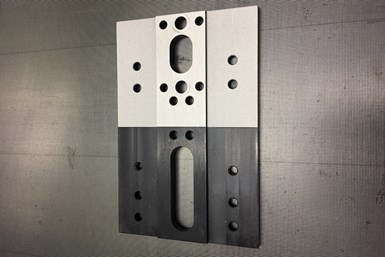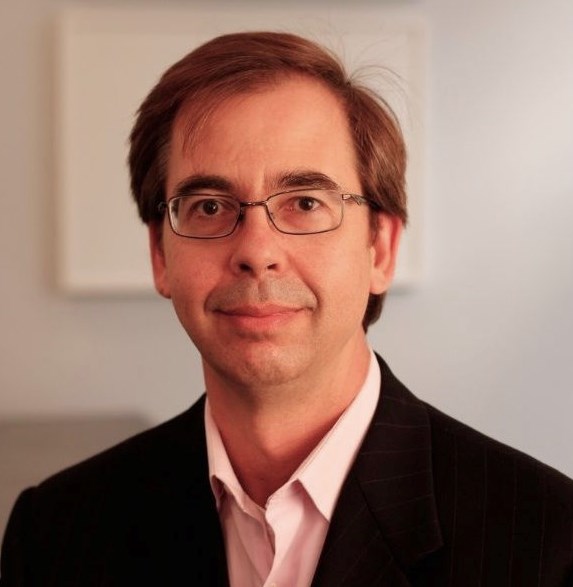Clean Technology Lasers for Coating Adhesion
Laser cleaning systems remove corrosion, grease, residue and existing coatings from metal surfaces quickly, with less preparation and mess than traditional techniques.
Laser systems remove corrosion, grease, residue and existing coatings from metal surfaces quickly and without the mess. Photo Credits: Laser Photonics
Most manufacturers understand the value of pretreating metal surfaces of parts to remove corrosion, grease, residue, old coatings, or to roughen the surface of metals prior to coating. By ensuring the items are cleaned down to bare metal, manufacturers can avoid costly warranty issues that result when coatings peel, flake, bubble or otherwise fail prematurely.
The traditional techniques used for this purpose — such as sandblasting, dry ice blasting, and chemical stripping — are messy and require expensive consumables, as well as substantial time for preparation and cleanup. These methods are also drawing scrutiny from regulators such as the Environmental Protection Agency (EPA) and the Occupational Safety and Health Administration (OSHA) since they can pose risks to the environment and applicators.
A more effective alternative is using industrial-grade, precision laser-based systems that can remove paint, contaminants, rust and residues with a high-energy laser beam that leaves the substrate unaffected. Preparation and cleanup time are minimal, and the low-maintenance equipment can last decades.
According to Vincent Galiardi, owner of Galiardi Laser Clean, a surface cleaning operator based in St. Charles County, Missouri, many people are surprised to learn that clean technology lasers are one of the most cost-effective, efficient and safe methods of industrial surface preparation.
The company has implemented laser systems made by Laser Photonics, a provider of industrial-grade CleanTech laser systems for cleaning and surface conditioning. The American-made systems function either as mobile standalone units or can be integrated into production lines.
Given its effectiveness in pretreating metal surfaces, these laser systems are increasingly being used in manufacturing facilities. The systems can be integrated into automated processing lines or technicians can use mobile handheld units. With significant advantages in safety and efficiency, laser cleaning is poised to disrupt the surface pretreatment market across more sectors.
Conventional cleaning limitations
Many applications in manufacturing require pretreatment of metal surfaces prior to coating. To improve coating adhesion, residue, oil or grease must be removed before coating. In some cases, a manufacturer may seek to further enhance coating adhesion by roughening the surface.
When defective metal parts are produced, instead of discarding the product,
CleanTech laser systems are available in portable and stationary models ranging from 50 watts to 3,000 watts with chamber sizes from 3 ft. x 3 ft. to 6 ft. x 12 ft. The systems can also be installed in manufacturing lines in cabinets or operated by a robotic arm. The units have a touchscreen that enables simple customization of several laser profiles to meet the needs of any project.
manufacturers can strip the paint and re-coat the component. To refurbish existing metal parts or recoat industrial infrastructure, removing the previous coating along with any corrosion is usually required to facilitate the new coating’s adhesion to the surface.
To pretreat metal surfaces, sandblasting, dry ice blasting or chemical stripping are traditionally used as industrial cleaning processes.
Sandblasting. Abrasive sandblasting involves forcefully projecting a stream of abrasive particles onto a surface, usually with compressed air or steam. The silica sand used in abrasive blasting typically fractures into fine particles and becomes airborne, which can cause serious or fatal respiratory disease.
When workers inhale crystalline silica, the lung tissue reacts by developing fibrotic nodules and scarring around the trapped silica particles, causing a fibrotic lung condition called silicosis. Estimates indicate that more than one million U.S. workers are at risk of developing silicosis and that more than 100,000 of these workers are employed as sandblasters.
In addition, particles are generated during abrasive blasting that further contribute to respiratory problems and other harmful health effects.
“Industry has needed a cleaner, safer surface pre-treatment solution for a very long time,” Galiardi says. “Sandblasting is inherently unsafe for operators. The silica glass used in sandblasting is toxic. An operator must wear a full HEPA suit when sandblasting to avoid breathing in particulates.”
Sandblasting is also time-consuming to clean up since the sand essentially scatters everywhere, even though it is usually considered a “fast” cleaning method.
“When we treat a surface with lasers, any fumes or dislodged particulate is extracted into a HEPA filter and the job is done.”
Dry ice blasting. With dry ice blasting, dry ice pellets are used as the abrasive. The challenge is that dry ice blasting is often not abrasive enough to sufficiently remove paint or corrosion from the surface of metals. Since dry ice is an expensive consumable, the costs can escalate when cleaning metal surfaces in higher volumes.
Chemical stripping. With chemical stripping, harsh, even toxic chemicals are used to strip metal-based objects of paint, rust and other contaminants to bare metal. However, for operators, exposure to corrosive acids and noxious chemical fumes is inherently dangerous. The process can also be time-consuming to prepare the proper chemical bath, achieve the required level of cleaning, and dispose of the waste. In addition, disposing of toxic chemicals is costly and closely regulated by agencies like OSHA and the EPA.
A clean, safe and fast approach
Laser-based systems have significant advantages over these traditional methods, including ease of use in which an operator simply points and clicks a high-energy laser beam at the surface. The substrate is not affected by the laser, and the systems do not create any mess or byproducts. The approach is eco-friendly, energy-efficient and completes the job in half the time of traditional methods when preparation and cleanup are considered.
“In our experience, laser cleaning is as fast at removing rust or old coatings as other methods, but without the same amount of cleanup,” Galiardi explains. “When we treat a surface with lasers, any fumes or dislodged particulate is extracted into a HEPA filter and the job is done. There is no media to replenish or clean up.”
CleanTech laser systems are available in portable and stationary models ranging from 50 watts to 3,000 watts (a 4,000-watt version is in development) with chamber sizes from 3 ft. x 3 ft. to 6 ft. x 12 ft. The systems can also be installed in manufacturing lines in cabinets or operated by a robotic arm. The units have a touchscreen that enable simple customization of several laser profiles to meet the needs of any project.
Corrosion and oil removal
Galiardi says laser pretreatment of metal surfaces can be used to streamline various manufacturing processes. Corrosion, for example, can begin to accumulate within a very short time on new parts, depending on the material and environmental conditions and should be removed prior to coating.
For one major auto manufacturer, Galiardi Laser Clean was asked to remove rust from conveying system components used to transport cars through the manufacturing process. The components were corroded due to being left outside during a six-month delay in the project. When it was time to install the items, the provider wanted to first treat the surfaces and return the components to a “like new” appearance.
With laser cleaning, prep and cleanup time can positively impact project cost.
In another example, Galiardi was asked to remove rust from over 400 transmissions in a couple of days. The laser systems are particularly effective when reaching into tight spaces that are hard to reach by hand. By masking the area to protect vulnerable parts, the laser can be applied without affecting the rest of the assembled product.
“No other parts [of the transmission] had to be removed and nothing had to be cleaned afterwards,” he says.
Galiardi’s company also used the laser system to remove cleaning oils from truck chassis. “We used the laser to remove the oil right before painting so it was a bare metal object going with nothing on it that would affect the coating,” he says.
Industrial plants that need to recoat existing metal structures also need to remove rust before painting. According to Galiardi, he removed corrosion from a large storage tank using the CleanTech laser system in about half the time of the alternative being considered, an abrasive disc grinder.
“Disc grinders basically just chip off [the rust] and it becomes airborne and makes a mess. Grinders can also be dangerous because sparks or debris can shoot off the wheel or catch an article of clothing,” he says.
With laser cleaning, prep and cleanup time can positively impact project cost. When the improved operator safety, equipment longevity and lower maintenance of laser systems are also considered, the clean laser technology has a much higher ROI, according to Galiardi. The longevity of low-maintenance laser systems further adds to their value, increasing ROI, and making replacement unnecessary for decades.
“CleanTech laser systems can last for 50,000 to 100,000 hours,” he adds. “That’s many decades working eight-hour days. After purchase, there’s virtually no maintenance necessary.”
About the Author
Stephen Armstrong
Stephen Armstrong is a freelance writer who has researched and written about industrial technologies, healthcare, automotive and international trade for the past 15 years.
Related Content
3-Stage Versus 5-Stage Washers
Columnist Rodger Talbert explains the difference between a five-stage washer and a three-stage washer, and how one provides better corrosion protection over the other.
Read MoreReplacing Open-Top Vapor Degreasing in Aerospace Manufacturing
Options and considerations for cleaning aerospace parts as regulations tighten on vapor degreasing solvents.
Read MoreImproving Wastewater Management Efficiency
Don’t find yourself underwater when managing wastewater processes. Follow these steps to improve efficiency and determine the best ROI.
Read MorePretreatment of Black Oxide
Having issues achieving a consistent color with the application of black oxide? Start by looking at your pretreatment. Connor Callais of Hubbard-Hall offers advice for troubleshooting your black oxide process.
Read MoreRead Next
How to Improve Liquid Corrosion Resistance
Q. How can we improve the desired corrosion resistance expected from our coating?
Read MoreCorrosion Resistance Testing for Powder Coating
Salt spray can be useful to help compare different pretreatment methods and coatings but it does not tell us much about the corrosion resistance of a part over time in the field. Powder coating expert Rodger Talbert offers insights into how to get a better idea of how to improve a part’s corrosion resistance in the real world.
Read MorePretreatment for Painting
Better adhesion, enhanced corrosion and blister resistance, and reduced coating-part interactions make pretreatment a must.
Read More
























